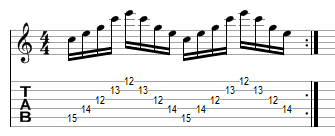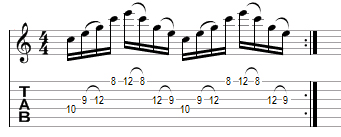So what is a so called advanced arpeggio? Basically they’re arpeggios that are played very quickly. The most common form of this is called sweep picking. Another kind less well known is called string skipping arpeggios. Although we’re aiming to play arpeggios very quickly, we’re still playing the notes of a chord one at a time, so we’re not playing them so fast as to be simply playing the chords.
First let’s take a look at sweep picking.

In some cases the tab may be annotated with the word ‘sweep’ to indicate sweep picking. The above example is a C major arpeggio, in that we are playing notes from the chord C major. Remember the three notes that make up C major are C, E and G. If you check for yourself you’ll see all the notes in the above example are either a C, E or G.
Let’s listen to the above example.
So how do we play the faster version?
The key things to remember when sweep picking, is that each note needs to be played one by one. We’re trying not to bleed the notes into each other. Before we move to the next note we want to kill the last note we’ve played. We do this by lifting our fretting finger off the fret we just played, but we still leave contact with the string briefly, this will mute the string. Or it should at least! Then we move to the next note.
Another point is the movement of the pick. As the name suggests we’re supposed to sweep the pick, or rake it along the strings in a fluid motion without stopping. We can’t play these arpeggios very quickly without this sweep. Sweep down in one motion, then sweep back up and then back down again.
As you can probably tell, combining a well timed sweep, with the difficulty of playing the notes quickly, combined with difficulty of muting each note one after the other quickly, is very difficult indeed.
The most common problems when things go wrong with sweep picking are,
1. Playing the sweep too quickly. It’s very easy to rush the sweep and rake the strings across the strings too quickly. Remember we’re still trying to play in time. In the above example we’re playing in 16th notes. So we’re aiming to play 4 notes per beat. This applies to the sweep also. To practice playing the sweep in time, set a drum machine or metronome to any time signature, slow at first, and just play the sweep in time. Don’t worry about your fretting hand, just mute all the strings and focus on the sweep. Aim to get it in time perfectly. You can then gradually speed the tempo up.
2. We’re not muting the notes well enough causing each note to interfere with one another. This can happen because we’re getting carried away and trying to play some monstrously fast sweep making it humanly impossible to mute the notes properly. Sweep arpeggios are fast by nature, but don’t get too carried away. Sweep picking sounds faster than they are, so pulling back a bit and slowing down will still sound impressive.
A common problem when we try to mute the strings happens when we lift our fingers off the strings. We play the note, then lift the finger off quickly, since we’re focused on the next note. But by lifting the finger off so fast we end up pulling off the open string causing unwanted noise to interfere with the next note. The finger we lift off the note, needs to be held a fraction longer on the string to kill the string before we lift the finger off completely. Practice this slowly as in the slow sound example and then try to speed up gradually.
All this sounds very difficult. And it is. Isn’t there another way to play arpeggios faster? Yes there is and it’s called string skipping arpeggios. Here is a example,

In this example we are playing the exact same notes from the C major chord as the example before. We’ve just rearranged the positions. If you listen to the sound files you’ll hear it’s the same notes also. Using this method we’re getting rid of the sweep and replacing them hammers and pull offs. Another thing you’ll notice is that when rearranging the positioning of the notes we’ve ended up skipping over the b string. This is where the name comes from!
One advantage of this method is that we’ve gotten rid of the need to sweep, so it’s much easier to play in time. Instead of having to sweep across 16 notes per bar like we did in first example, here we’re playing the exact same thing, but we only need to pick 10 times per bar. So we can handle this picking normally. Instead of looking like some monster arpeggio it ends up looking more like a regular legato lick.
However it’s not all good news. Trying to play this method quickly also has a problem. That string skip. Leaping over that string rapidly without accidently bumping it can be a problem. Also the hammers and pull offs can end up sounding weak when playing so fast. We play so quickly that we’re not applying good legato technique that we learned in the legato lesson. Such as firm contact and lifting our fingers off at a angle.
So which method is better?
Well try them for yourself and decide which you think is easier. Or you may decide that neither of them is worth the time and hassle! That’s entirely up to you, very few guitarists, ourselves included, use these techniques often. And depending on your musical style, it may be totally unneeded. I can’t think of too many reasons why it would sound good to sweep pick in a pop song for example.
The previous examples looked at the core techniques involved in playing arpeggios quickly. Now let’s look at how we can actually use these methods in real music.
First is a example that uses sweeping.

First of all we can see we’re only sweeping through three strings, and it’s also very common for guitarists to add hammers to sweep licks. So we simply need to sweep downwards from the g string to the top e string, then hammer up to the next note. Then just move down to each new position. The whole example is played in G major, in that we’re only using notes from the G major scale.
The most important thing to watch out for in this example is the timing. The whole example is played in even 16th notes, that is, the difference in time between each note should be equal. It’s easy to get out of time and play the sweeps to fast, or play the hammers to fast or too slow. Everything should be steady and even. Listen to the example to hear for yourself. As with everything when playing guitar, practice slowly at first to get the timing right, and then gradually speed up.
Now let’s look at an example using string skipping.

In this example we’re using the same major scale arpeggio shape from the previous string skipping example, and just moving it up and down the neck making sure we stay in key. In this case we’re in the key of C major.
All the same difficulties of playing string skipping arpeggios apply here also, only this time we have the added headache of moving quickly to new positions. Concentrate on timing and sounding the hammers and pull offs clearly. If the hammers and pull offs sound weak then the whole lick will sound feeble. Again, start slowly and gradually speed up.
So there we have sweeping arpeggios and string skipping arpeggios. If you enjoyed the sound of either of those techniques, try applying them to different chords and different positions. Have fun!
- When we need to play certain arpeggios very quickly we need to either sweep, or string skip arpeggio.
- When sweep picking we need to concentrate on muting notes after they are played, we dont want the notes to overlap.
- String skipping arpeggios are a way of playing arpeggios fast, but without the need to sweep.
- When using either method be careful to keep things in time. It can be easy to rush parts of these very fast techniques.
- Dont over do it. These techniques are meant to be played fast, but go to fast and you’ll have a impossible lick.
- As always, start slow and gradually speed up.
